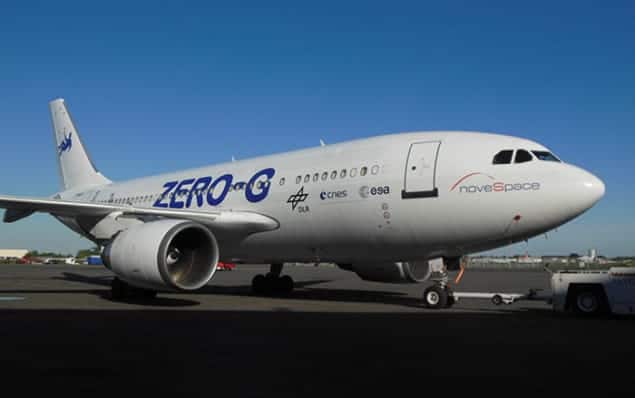
“Weightless” experiments that compare the gravitational acceleration of two different quantum objects have been performed by physicists in France. Carried out in free fall on board an aircraft undergoing a parabolic trajectory, the tests were far too insensitive to test the long-held idea that all bodies fall at the same rate (in a vacuum) in a given gravitational field. However, the research could lead to far more powerful space-based experiments and might also result in the development of new navigational aids.
The universality of free fall is a consequence of the equivalence principle, which lies at the heart of Einstein’s general theory of relativity. It states that inertial and gravitational mass are equal, which means that a body’s mass – or indeed its internal structure – has no bearing on its acceleration in a gravitational field. Therefore two bodies with different masses or compositions will accelerate at the same rate.
Universality has been tested to ever greater precision since Galileo’s mythical experiment at the Leaning Tower of Pisa – and, so far, has never failed. The most precise experiment to date was carried out in 2008 by researchers at the University of Washington in Seattle, who found that universality held to one part in 1013.
Microscope in space
Physicists would like to boost precision by at least a factor of 100, since it as this level that some theories beyond the Standard Model of particle physics predict that the universality of free fall will break down. In fact, one space mission already in orbit around the Earth – the Micro-Satellite à traînée Compensée pour l’Observation du Principe d’Equivalence (Microscope), developed by the French National Centre for Space Studies (CNES) – is designed to reach a sensitivity of about 10–15 and could produce its first significant results early next year.
Microscope takes advantage of the fact that orbiting satellites are in free fall towards the Earth. Therefore objects inside the satellite are themselves in free fall for far longer than any mass dropped on Earth. This means that acceleration measurements can in principle reach very high sensitivities.
Microscope, like the University of Washington experiment, studies the free fall of large “classical objects”. In contrast, the latest work, carried out by Philippe Bouyer and Brynle Barrett of the LP2N laboratory in Bordeaux and colleagues, uses “quantum objects”. These are extremely cold clouds of two types of atom: rubidium-87 and potassium-39. Atomic systems have a number of advantages over macroscopic objects, according to Bouyer, including the fact that there is no possibility of contamination by unknown quantities of impurities. Also, spin and other quantum-mechanical properties of the atoms can be varied to see if this causes a violation of the equivalence principle.
Struck by lasers
The rubidium and potassium atoms are allowed to fall under the influence of gravity. As they drop they are struck by lasers, which acting as a beam splitter for matter, causes the atoms’ wave packets to split and follow two vertical paths at the same time. At the end of their trajectory, the two states interfere with one another, producing an interference fringe. Comparing the position of the fringes produced by the rubidium and potassium then allows the researchers to establish whether the two different types of atom have undergone different relative phase shifts and hence experienced very slightly different accelerations.
Physicists have previously used cold-atom interferometers to investigate the universality of free fall, having achieved sensitivities of around 10–8, but these experiments were performed on the ground. As with classical tests, the ultimate aim is to go into space. Bouyer and colleagues haven’t yet managed that, but have instead taken advantage of the near weightless conditions on board a specially adapted Airbus aeroplane owned by French company Novespace. The “zero-G” aircraft undergoes free fall for about 20 s at a time by climbing at an angle of around 45° and then cutting its engines just enough to cancel its air drag, so that it traces out a parabola as it accelerates downwards under gravity. The plane then drops, noses up again and traces out another free-fall parabola, repeating the cycle many times over.
Bouyer and colleagues have carried out nearly 10 years of painstaking work on many parabolic flights to stabilize their complex equipment in the noisy environment of the aircraft. This allowed them to perform tests on rubidium-87. Now, the team has compared the behaviour of two different types of atom over the course of six flights last year.
Suitable for space
Barrett says that the work relies on a number of technical innovations to reduce the effects of on-board vibrations, which can reach about 0.01 g, and the aircraft’s rapid rotation, which can get up to one revolution per minute during a parabola. Noting that he and his colleagues tested the universality of free fall with a modest sensitivity of just 3 ×10–4, he says that the importance of the work was in showing the suitability of their set-up for space-based tests. “The techniques we developed here could be exploited by many experiments over the next few years,” he predicts.
The team’s next step is to carry out new tests early next year to show how single atoms could be used for “inertial” navigation, which involves continually monitoring a body’s acceleration and rotation over time. Beyond that, some group members are also working to exploit the interferometer technology on a mission known as the Space-Time Explorer and QUantum Equivalence Principle Space Test (STE-QUEST). But according to Bouyer, the roughly €500m satellite will not launch until at least 2025. “It is a big, long term project,” he says.
The research is described in Nature Communications.
- There is much more about tests of the equivalence principle in “The descent of mass”



